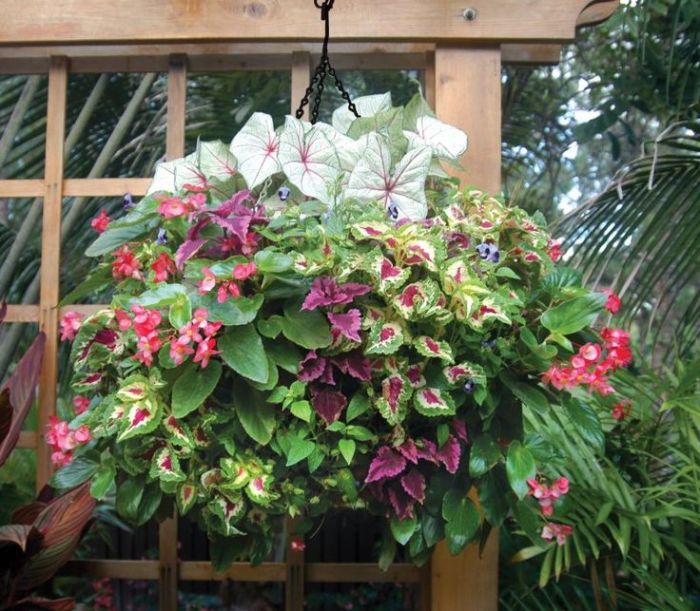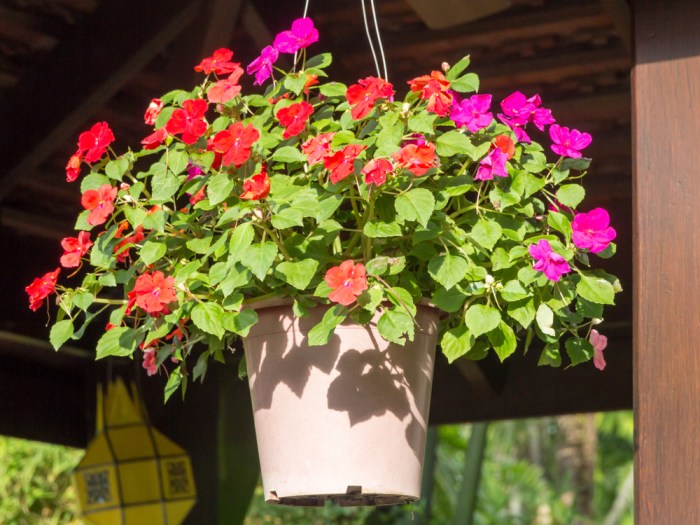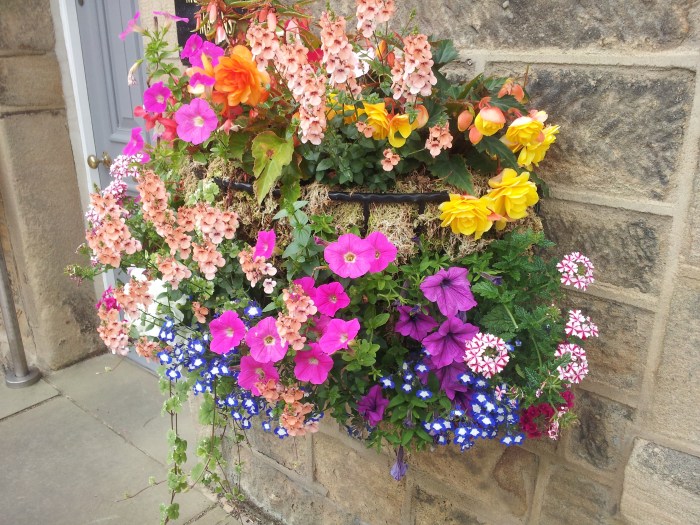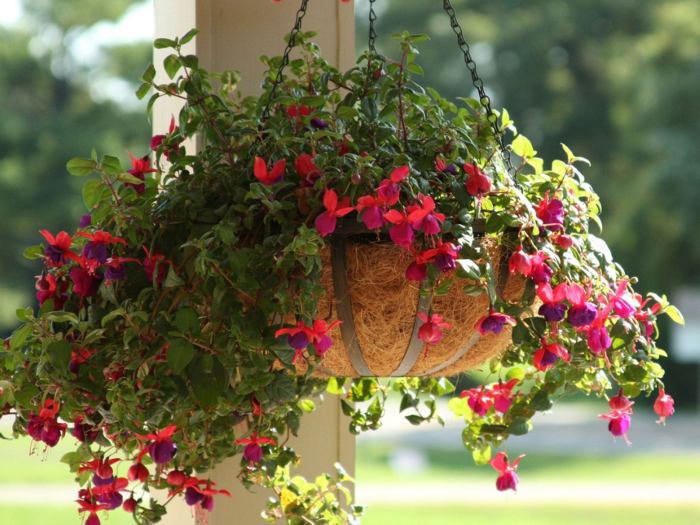Hanging basket plants in shade offer a touch of beauty to any shaded area, bringing color and life to patios, balconies, and porches. With the right care and maintenance, these plants can thrive in low-light conditions, creating a lush and inviting atmosphere.
From flowering begonias to trailing ferns, there are a variety of plants that excel in shaded hanging baskets. With proper watering, fertilization, and pruning, these plants can provide year-round interest and enjoyment.
Ideal Shade Plants for Hanging Baskets: Hanging Basket Plants In Shade

Hanging baskets are a beautiful way to add greenery and color to shaded areas of your home. When choosing plants for hanging baskets in the shade, it is important to select varieties that can tolerate low light conditions.
Hanging basket plants in shade offer a lush, verdant touch to outdoor spaces. To maintain their health and beauty, it’s essential to follow proper trimming techniques. Just as pruning fig plants is crucial for optimal growth, so too is trimming hanging basket plants in shade.
Regular pruning promotes air circulation, removes dead or damaged leaves, and encourages new growth, ensuring that your hanging baskets remain vibrant and healthy throughout the season.
Here is a list of some of the best shade-loving plants for hanging baskets:
Flowering Plants
- Fuchsia( Fuchsia spp.): Fuchsias are popular hanging basket plants known for their showy, bell-shaped flowers that come in a variety of colors.
- Impatiens( Impatiens walleriana): Impatiens are another popular choice for hanging baskets, producing masses of colorful flowers in shades of pink, red, orange, and white.
- Begonia( Begonia spp.): Begonias are known for their beautiful foliage and delicate flowers. They come in a wide variety of colors and shapes.
Non-Flowering Plants
- Ferns( Pteridophyta spp.): Ferns are a great choice for adding a touch of greenery to hanging baskets. They come in a variety of shapes and sizes, and many varieties can tolerate low light conditions.
- Ivy( Hedera spp.): Ivy is a popular trailing plant that can be used to create a lush, cascading effect in hanging baskets.
- Spider plant( Chlorophytum comosum): Spider plants are known for their long, arching leaves and easy-to-grow nature. They are a good choice for beginners.
Care and Maintenance of Hanging Basket Plants in Shade
Hanging basket plants in shaded locations require specific care to thrive. Understanding their water, nutrient, and pruning needs is essential for their health and beauty.
Watering
Water hanging baskets in shade when the soil surface feels dry to the touch. Avoid overwatering, as this can lead to root rot. Use a watering can or hose with a gentle spray to evenly distribute water throughout the basket.
Fertilization
Fertilize hanging basket plants in shade every two to four weeks during the growing season. Use a balanced liquid fertilizer diluted to half strength. Avoid over-fertilizing, as this can burn the plants.
Hanging basket plants in shade thrive in the dappled light, offering a lush and inviting atmosphere to any outdoor space. While these plants require minimal maintenance, it’s important to consider the benefits of pruning to enhance their health and beauty.
Prune Your Cactus Houseplants for Health and Beauty provides expert guidance on the art of pruning, helping you maintain the vitality of your hanging basket plants in shade. This comprehensive guide covers techniques for removing dead or diseased leaves, shaping plants for optimal growth, and encouraging new blooms.
Pruning and Deadheading
Regular pruning and deadheading help maintain the shape and vigor of hanging basket plants. Remove any dead or yellowed leaves and stems. Pinch back the tips of stems to encourage branching and fullness.
Design Considerations for Shade Hanging Baskets

Creating aesthetically pleasing hanging baskets for shaded areas requires careful consideration of several design factors. These include:
Color Combinations and Contrasts
In shady environments, vibrant colors can brighten the space. Consider using contrasting colors to create visual interest. For example, deep purple foliage paired with bright yellow blooms can create a striking effect.
Plant Textures and Shapes
Varying plant textures and shapes adds depth and dimension to hanging baskets. Combine soft, flowing plants like ferns with upright or trailing varieties to create a dynamic display. Contrasting leaf shapes, such as round and elongated, can also enhance visual appeal.
Hanging basket plants in shade bring a touch of greenery and life to shaded areas. For those seeking natural options, real hanging plants offer a wide variety of species that thrive in low-light conditions. These plants can add texture, color, and interest to any shady corner, creating a serene and inviting atmosphere.
Hanging basket plants in shade are a versatile and practical way to enhance the beauty of outdoor spaces without sacrificing greenery due to limited sunlight.
Container Styles and Materials
The choice of container can complement the overall design. Consider using materials like terracotta, metal, or wicker that complement the surrounding décor. Vertical containers can maximize space in smaller areas, while wider baskets allow for more elaborate plant arrangements.
Troubleshooting Common Problems

Growing hanging basket plants in shade can present certain challenges, but with proper care and attention, these problems can be easily addressed.
Nutrient Deficiencies
Nutrient deficiencies can manifest in various ways, such as stunted growth, yellowing leaves, or poor flowering. To address this issue, use a balanced fertilizer specifically formulated for hanging baskets and apply it according to the manufacturer’s instructions. Additionally, consider using a slow-release fertilizer to provide a steady supply of nutrients over time.
Pest and Disease Infestations
Hanging baskets in shaded areas may be more susceptible to pests and diseases due to reduced air circulation. Regularly inspect plants for signs of infestation and take prompt action to control the problem. Use organic or chemical pest control methods as necessary, following the instructions carefully.
For disease prevention, ensure proper drainage and avoid overwatering.
Hanging basket plants can thrive in shady areas, adding a touch of greenery to any outdoor space. If you’re looking for a comprehensive guide on how to trim your weed plant during flowering, look no further than How to Trim Your Weed Plant During Flowering: A Comprehensive Guide . With detailed instructions and expert tips, this guide will help you achieve the perfect trim for maximum yield.
After trimming, return to your hanging basket plants in the shade, ensuring they receive ample water and occasional fertilizer to maintain their vibrant foliage.
Waterlogging or Drought Stress
Waterlogging or drought stress can occur if the hanging basket does not have proper drainage or if watering is not consistent. Waterlogging can lead to root rot, while drought stress can cause wilting and stunted growth. To prevent waterlogging, ensure that the hanging basket has drainage holes and use a well-draining potting mix.
To avoid drought stress, water the plants regularly, especially during hot and dry weather.
Creative Hanging Basket Ideas for Shade

Innovative and visually appealing hanging basket ideas for shaded areas bring a touch of greenery and color to any outdoor space. From vertical gardens to mixed planters, these ideas offer creative ways to add life and style to shady nooks and crannies.
Vertical Gardens
Hanging baskets can be transformed into vertical gardens, creating a living wall that adds height and interest to shaded areas. By suspending baskets vertically, gardeners can maximize space and create a lush, green display.
Mixed Planters
Mixed planters combine complementary plants in a single hanging basket, creating a visually stunning arrangement. Choose plants with varying textures, colors, and heights to create a dynamic display. Companion planting, where beneficial plants are grouped together, can enhance growth and health.
Decorative Accents, Hanging basket plants in shade
Hanging baskets can also serve as decorative accents, adding a touch of whimsy or elegance to shaded areas. Choose baskets with intricate designs or bold colors to create a focal point. Incorporate fairy lights or wind chimes for added ambiance.
Closure
Whether you’re a seasoned gardener or a novice, hanging basket plants in shade are an easy and rewarding way to add beauty to your outdoor space. By following the tips Artikeld in this guide, you can create stunning arrangements that will thrive in the shade and bring joy for seasons to come.
Helpful Answers
What are the best plants for hanging baskets in shade?
Suitable plants include begonias, ferns, impatiens, and coleus.
How often should I water hanging basket plants in shade?
Water when the top inch of soil feels dry to the touch.
How can I prevent nutrient deficiencies in hanging basket plants in shade?
Fertilize every two weeks with a balanced liquid fertilizer.